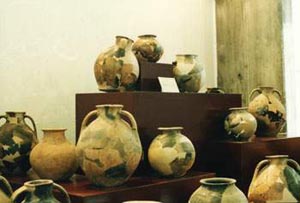1986-88 Salvage Excavations
- English
- Türkçe
As one of the tumuli of the Phrygian Necropolis in Ankara was partly and another entirely destroyed by scoops during the construction of the Gençlerbirliği Sports Establishment in 1986, a salvage excavation project was realized at the site in 1986-88 jointly by METU Museum and Archaeological Research Centre and the Museum of Anatolian Civilizations under the scientific consultation of Prof.Dr. Sevim Buluç. New archaeological methods were applied in the re-excavation of the surviving parts of these two tumuli, which had previously been excavated by T. Macridy in the year 1925.
Archaeological discoveries confirming to descriptions given in written historical sources like Hittite texts or Homeric epics on burial customs revealed out of these excavations: Sections of the excavation pit trenched at the location where scoops had penetrated into the tumulus clearly demonstrates the construction technique of the tumulus. The burnt layer on the flattened soil extending from the central part of the hill towards the eastern side indicates the location of a cremation ceremony. The tumulus had been constructed on this burnt layer by accumulating different heaps of earth, which may be distinguished from differences in colour ant texture, into small mound.
Bones belonging to two oxen with potsherds on two sides were recovered over a thin layer of soil enclosing the burnt logs in a vertical trench opened at the east corner of the tumulus. The thin white layer over the logs indicates that the logs had been covered with earth immediately after the fire had been extinguished with a liquid. Several of the large logs must have continued to burn from the inside to turn into charcoal and later collapsed under the load of the earth layer above, due to which some of the bones and pottery had fallen into the fire and got burnt considerably while others were preserved unburnt.

Pottery from Beştepeler Tumulus, 6th century B.C.
At the immediate south of the cremation area is a small area halved by scoops; ash and pieces of burnt bones were discovered inside a pot adjoining the logs from the left. Another burnt group was detected again at the south, a little away from the cremation area. Pottery discovered here also bear traces of fire. Among them were at least two highly deformed terracotta kilns or braziers. Removing the pottery and clinkered kilns, timber and bronze plates were discovered at a lower level.
Several of the highly burnt and charcoaled findings here must have belonged to a thick round wheel. Additional findings resembling yokes and axle tips as well as some bronze rings bring forth the possibility of a carriage having been burnt. Although one thirds of the cremation area had previously been destroyed by scoops, that part of it which leads towards the centre of the tumulus was totally unearthed and documented.
Two trenches cut into the central part of the tumulus in the year 1988 indicated that the burial chamber inside had most probably collapsed, as was the case in other previously mentioned examples. As the excavations penetrated down from the top of the hill, a pit dug into the main soil was discovered at 10m, with four stone masonry walls without mortar, two of which were fairly preserved while the other two had been totally spoiled by the trench cut by T. Macridy. Traces indicating the presence of a timber chamber and a small fragment from a fibula were detected among these 1.5m-thick heaps of stone and at the bottom. The similarity of this fibula fragment with another fibula recovered from the cremation area as well as section characteristics of layers of earth heaps in the trenches point to the possibility of the burial chamber's being contemporary with the cremation ceremonies. Based on the stylistic analysis of fibulae, the tumulus has been dated to a period between the end of 7th century BC and the beginning of 6th century BC.
Finds from these excavations are currently exhibited at METU Archaeological Museum.
